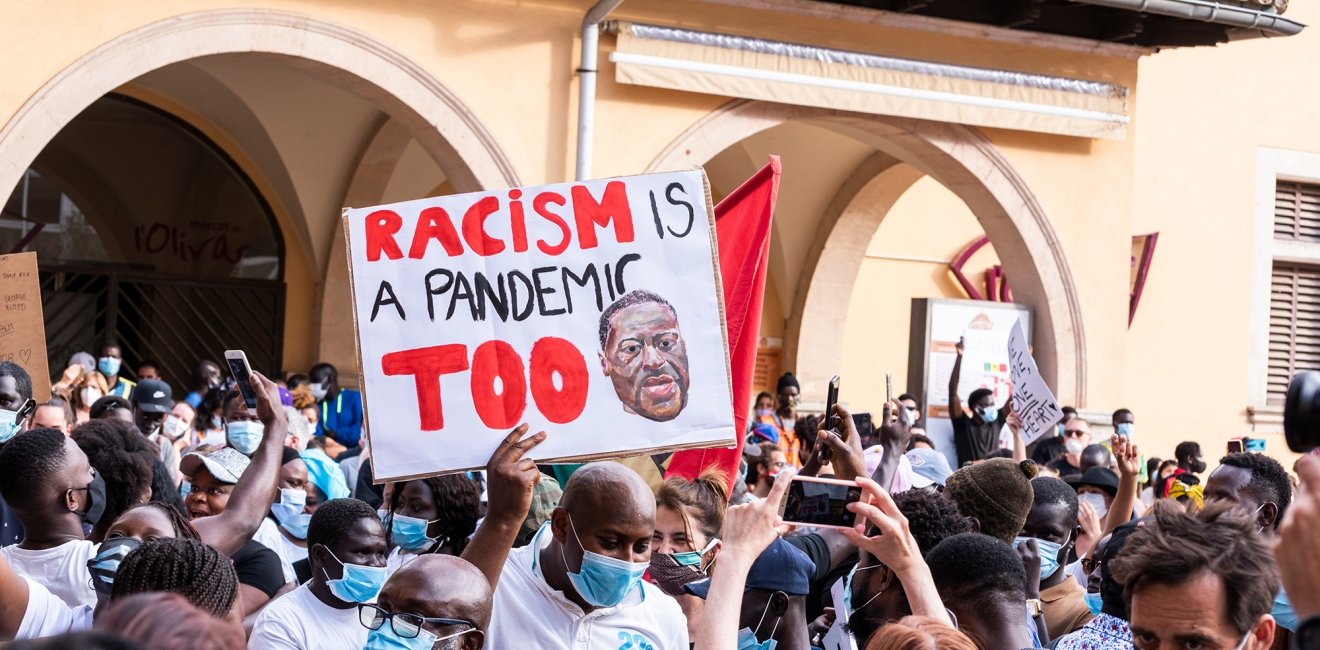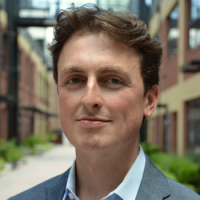Science Policy and the Now
Scientists commonly take pride in the nonpartisan nature of numbers and results that support theory. But the evidence and science behind the erosion of Black and brown health in America needs to put under the microscope.

A blog of the Science and Technology Innovation Program
Scientists commonly take pride in the nonpartisan nature of numbers and results that support theory. But the evidence and science behind the erosion of Black and brown health in America needs to put under the microscope.

When news reports first identified the uneven health effects of COVID-19 on communities of color, the infectious disease experts, conservationists, and even physicists on my science policy-skewed Twitter feed let out a collective “Of course there are.” But, to the surprise of many in those fields, most of America was scratching its head.
My own friends did not know that Black women have a reported three times higher maternal mortality than non-Hispanic white women. I was surprised to learn that colleagues had no idea about the subconscious and sometimes overt racism by doctors who ignore Black people’s pain inside the clinic and gloss over their hurt as an overreaction. I was surprised to learn that so few of the people around me were aware of issues like the fatal effects heat islands have in predominantly Black and brown neighborhoods and how our nation was built to perpetuate these through redlining. My surprise was rooted in my ignorance that comes with the repetition of a message.
As a graduate student, there was always a slide tacked on to the end of lectures I would prepare for on subjects like mental health or communicable diseases addressing the “Effects on Minorities”. As a member of a marginalized community myself – a queer, albeit white, man – I was particularly sensitive to this habit of adding-on figures and statistics about the impact of disease on minority populations.
Though LGBTQI+ policy issues were personal and abundant, I thought of them as fertile ground for change. But there was a consistent and more troubling message academia presented: a seemingly immutable law of American public health and scientific study that everything bad is worse for those in “low-income communities” or those considered the “urban poor” (common proxies for people of color).
I wasn’t quite sure how to tackle the problem then—herein lies the difference between seeing something as the exception, queer marginalization, rather than the rule, racism. Upon further examination, it now seems incomprehensible that systemic racism felt impossible to dismantle yet climate change was frequently presented as a ripe area for inspiring and achievable structural reform. But if this pandemic has taught anything, it’s that those in the science policy community must actively address this systemic challenge with creative ideas, now. We have been trained to tackle seemingly insurmountable problems, and just because it’s hard doesn’t mean we shouldn’t try.
Many new leaders in the biomedical sciences and associated policy spheres have found their voice by articulating the nuances COVID-19. Twitter followings have gone up and the public’s eye on the scientific community has never been wider. Now is the time to capitalize on that voice we have found and use it again and again to speak on the facts, theories, and results that we may have been unintentionally harboring.
Some of us are sitting on the knowledge that has bookended countless webinars, meetings, and talks. Others at least have the skills to analyze and propagate studies connecting the wellbeing of people of color and diabetes, mistrust in the medical system, discrepancies in access to care, air pollution in urban centers, unintended consequences of facial recognition software, representation in clinical trials, effects of racism induced stress on cortisol levels and immunity, the prevalence of food deserts in predominantly Black and brown communities. Or explain why the murders of Ahmaud Arbery, Breonna Taylor, George Floyd and many others should stay in the headlines until justice is achieved for all.
Scientists commonly take pride in the nonpartisan nature of numbers and results that support theory. How those results are used is not a scientist's job—usually. In this case, the evidence and science behind the erosion of Black and brown health in America are not partisan issues but they are political— and science has always been political. Political in that there are decisions to be made that science can inform. Political in urgency.
In the first few weeks and months of the COVID-19 pandemic, legislative proposals and punditry started to circulate attempting to patch the holes on a ship already at sea. These proposed solutions ran the gamut from direct payments to US citizens to implementing environmentally conscious legislation on industries that suffered a substantial financial hit.
To some, these new regulations added insult to injury— further hamstringing already struggling companies to provide those on the left with a non-COVID-19 related win. But like climate change, like systemic racism, and like the response to COVID-19 patching together policies cannot fix a broken system. COVID-19 is more than likely a disease of zoonotic origin caused by human interactions with animals exacerbated by globalization, overpopulation, and climate change-induced environmental sequestration. To solve systems problems, single-use policies are insufficient.
Pandemic prevention, a systems problem, must be tackled on a holistic scale taking into account the drivers of the modern pandemic era. This means addressing the dominos before they fall, before the next spillover event. The interconnected nature of our world may have once been hard to articulate but COVID-19 presents an opportunity to thread the needle on these nuanced conversations. With a broader understanding of systems thinking architecture, supported by the facts and figures science professionals already know, addressing health disparities for minority communities can be portrayed as a complex yet feasible policy action.
Take the issue of heat islands in urban areas. In the article mentioned above, the EPA reports, with statistics from the CDC, that between 1979 and 2003 excessive heat contributed to more premature deaths in the United States than hurricanes, lightning, tornadoes, floods, and earthquakes combined. These excessive heat events are caused by poor air quality, low levels of tree cover, sparse green space, and a lack of cooling infrastructure. Climate change and the rise in temperature have only made these heat events worse and more common.
Then add findings from a report from the Science Museum of Virginia and others published in January 2020, that 94% of neighborhoods in historically redlined communities had a significantly higher temperature than geographically similar non-redlined communities. These historically redlined communities are marked today by high levels of poverty and low income which disproportionally encompasses Black and brown populations. The scientific paper ends with:
…the preponderance of evidence establishes that those experiencing the greatest exposure to present and potentially future extreme heat are living in neighborhoods with the least social and ecosystem services historically.
In addition, COVID-19 is spreading at historically high rates and the country is observing an escalation in cases rather than the much talked about, but unsubstantiated claims, of a warm weather reprieve. As the cases go up and people are encouraged to stay indoors, the heat will naturally increase, and heat events will inevitably follow. This presents a further challenge to the Black and brown community members in these low income and highly urbanized zones. With lower access to AC and discouraging messages concerning public pools and beaches, those already at the highest risk for severe cases of COVID-19 are then at higher risk for heat-related complications.
Two different scientifically understood and supported disparities both rooted in systemic oppression. This is without adding into the mix an impending housing crisis.
Truly innovative science policy actions cannot only advocate for adding heat stress resistant buildings and using green infrastructure or increasing the quality, numbers, and size of outdoor parks and green spaces. In this case, the necessary and new science-based policies should be argued for and seen as a package deal with economic policies necessary to reverse the lasting effects of redlining and with it the continued financial neglect of underserved communities.
This could be achieved by tightening oversight on bank lending to Black American’s who are all but required to live in these areas after unjustly not getting approval for loans based on their race. Other structural policies would include reconfiguring the streets and flow of traffic through these neighborhoods or implementing progressive affordable housing policies to quell rampant gentrification and begin to reverse or halt the forced migration of minority populations further into communities that are structurally unhealthy.
Those lucky enough to work within the science policy ecosystem have the unique opportunity to push for a systems thinking approach in the inevitable deluge of legislation in state houses across the country as well as in the US Congress meant to restructure and reform the United States as the pandemic moves off the front page. But it is not just incumbent on those in political leadership roles today to learn, talk about, and apply pressure to these issues.
To those who work in science or at its boundaries but have not taken a class or sat in on a lecture on the above or similar subjects, this is still a moment for self-reflection. Now is the time to ask yourself why you skipped the session on inclusion and equity at the annual conference you attended last year? Was it for lack of time, lack of care, or because you saw it as too big a problem for you to solve? Or, why you perhaps felt empowered to speak on the science of the pandemic to friends and family but not the science behind the effects of racism?
Science has failed communities in the past and too often perpetuates these failures through hiring or silence. As we are in the throes of a climate crisis, a pandemic, and unprecedented civil unrest the time to speak up, loudly, is now.


The Science and Technology Innovation Program (STIP) serves as the bridge between technologists, policymakers, industry, and global stakeholders. Read more
